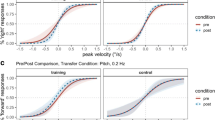Abstract
We determined the relative contributions of gravity-dependent positional cues and motion cues to the learning of roll balance control. We hypothesized that gravity-dependent otolith and somatosensory shear forces related to body orientation would yield better initial performance, more rapid learning, and better retention. Blindfolded subjects rode in a device programmed to roll with inverted pendulum dynamics in a vertical (UPRIGHT) or horizontal plane (SUPINE), and used a joystick to align themselves with the direction of balance. Each subject completed five blocks of four 100 s long trials on two consecutive days in one of four groups (n = 10 per group): Group 1, UPRIGHT balancing both days; Group 2, SUPINE both days; Group 3, UPRIGHT then SUPINE; and Group 4, SUPINE then UPRIGHT. On Day 1, UPRIGHT subjects showed better initial performance and greater improvement in performance than SUPINE subjects, who showed improvements only in having fewer deviations exceeding ±60 deg from the direction of balance. Subjects tested UPRIGHT on both days showed full retention of learning across days and additional Day 2 learning, but subjects tested SUPINE on both days showed partial retention of their marginal learning from Day 1 and little improvement on Day 2. Subjects tested SUPINE on Day 2 after being tested UPRIGHT on Day 1 showed no better performance than subjects tested SUPINE on Day 1. By contrast, there was transfer from SUPINE on Day 1 to UPRIGHT on Day 2. We conclude that absence of gravitationally dependent otolith and somatosensory cues degrades balance performance.



Similar content being viewed by others
References
Collins JJ, De Luca CJ (1993) Open-loop and closed-loop control of posture: a random-walk analysis of center-of-pressure trajectories. Exp Brain Res 95:308–318
Collins JJ, De Luca CJ (1995) Upright, correlated random walks: a statistical-biomechanics approach to the human postural control system. Chaos. 5:57–63
Guedry F et al (1971) Use of triangular waveforms of angular velocity in the study of vestibular function. Acta Otolaryngol 71:439–448
Horak FB, Shupert CL, Mirka A (1989) Components of postural dyscontrol in the elderly: a review. Neurobiol Aging 10:727–738
Lackner JR, DiZio P (2009) Angular displacement perception modulated by force background. Exp Brain Res 195:335–343
Lackner JR et al (1999) Precision contact of the fingertip reduces postural sway of individuals with bilateral vestibular loss. Exp Brain Res 126:459–466
Lambert JD (1973) Computational methods in ordinary differential equations. Wiley, Hoboken
Metcalfe T, Gresty M (1992) Self-controlled reorienting movements in response to rotational displacements in normal subjects and patients with labyrinthine disease. Ann N Y Acad Sci 656:695–698
Nooij SA, Groen EL (2011) Rolling into spatial disorientation: simulator demonstration of the post-roll (Gillingham) illusion. Aviat Space Environ Med 82:505–512
Panic H et al (2015) Direction of balance and perception of the upright are perceptually dissociable. J Neurophysiol 113:3600–3609
Panic AS et al (2017) Gravitational and somatosensory influences on control and perception of roll balance. Aerosp Med Hum Perform (in press)
Rey MCB et al (2016) Vestibular perceptual thresholds increase above the age of 40. Front Neurol 7:162–179
Vimal VP, Lackner JR, DiZio P (2016) Learning dynamic control of body roll orientation. Exp Brain Res 234:483–492
Acknowledgements
This work was supported by the Air Force Office of Scientific Research AFOSR FA9550-12-1-0395. We thank Avijit Bakshi, Heather Panic, Sacha Panic, Alberto Pierobon and Joel Ventura for technical support and advice.
Author information
Authors and Affiliations
Corresponding author
Rights and permissions
About this article
Cite this article
Vimal, V.P., DiZio, P. & Lackner, J.R. Learning dynamic balancing in the roll plane with and without gravitational cues. Exp Brain Res 235, 3495–3503 (2017). https://doi.org/10.1007/s00221-017-5068-3
Received:
Accepted:
Published:
Issue Date:
DOI: https://doi.org/10.1007/s00221-017-5068-3




